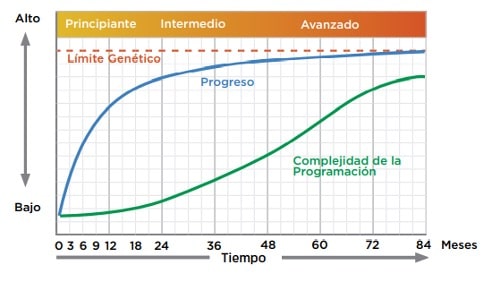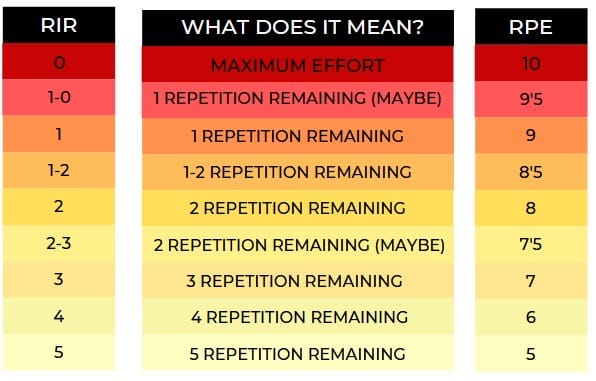11 de March de 2021
Basic strength training for athletes: guide to start!
It is a reality that physical activity and sport are becoming more and more important in people’s daily lives. Something that was hardly important before, beyond regulated competitions and professionals in the sector, today and due to the rise of fitness, more and more people want to start training and are specifically interested in strength training. However, starting this journey can induce many questions: Where do I start? How do I structure a routine? What is the most important? What are the fundamental concepts? 1RM? RPE? RIR?
If you want to train and know what you are doing but still don’t know how to start your sessions, keep reading! Like building a house, we have to start with the basics – to understand how the plans are read. To start training, you must first know the most basic concepts that will allow you to understand more complex concepts afterwards.
More information: 5 tips from professionals to improve your strength
Plan your strenght training sessions
Recognize the Microcycles and Mesocycles of your strength training.
One of the most common ways to plan workouts is through mesocycles and microcycles, but what is that and how can it help you?
- Microcycle: it is a work cycle or set of sessions, which is carried out in a period of time between 4 and 10 days, usually 7 days.
- Mesocycle: it is the training period that combines a certain number of microcycles that respond to a common goal and objectives. For example, a set of microcycles that have a common goal generally lasts 1 month (4 microcycles of 7 days).
- Macrocycle: is the set of several months and weeks that form long-lasting cycles.
In this way, you can plan your training sessions a week, a month or even several months ahead when we are more advanced. For now, being beginners, it is advisable to periodize one or two microcycles to see how we are feeling and then plan the entire mesocycle.
What exercises to do according to my strength training level?
Being a beginner, it is much more advisable to select multi-joint exercises or those exercises that involve a large part of your body. It is preferable to learn to do a squat, which involves many more muscles, such as the quadriceps, abductors, buttocks and core among others, than going to the gym to sit on a machine to extend the knee, which only benefits the quadriceps.
In addition to performing more complete exercises where much more muscle mass is involved than single joint exercises, you will advance faster and feel that you progress quicker, giving you that motivation to continue training.
As beginners, the importance of technique should be taken into account, especially in these exercises in which several joints are involved at the same time. We must spend some time at the beginning learning how to perform the different exercises, where we should put the focus of attention, which muscles are going to be stimulated, etc. In addition to knowing the correct technique and forming a firm base where to build and improve our performance afterwards, we will avoid possible injuries derived from bad technique.
How do I organize the routine and the exercises?
There are multiple types of routines according to the weekly division: torso-leg, full body, pull-push-leg, Weider, P.H.A.T, etc. For a beginner who has never strength trained before and starts training, choosing the type of beginner plan should not be stressful, since any type of stimulus at a certain intensity will produce notable progress every week due to the very large room for improvement.
When you are starting out you have a lot of things to learn, so the most appropriate thing is to start with a simple program, with a limited selection of exercises and with a high margin of improvement, which aims to train the whole body efficiently from multi-joint movements. As you improve, you will have to refine your training schedule to keep progressing.
 Figure 1. “The Muscle and Strength Pyramid”
Figure 1. “The Muscle and Strength Pyramid”
The easiest to follow and those that can produce more adherence at the beginning are usually full body, torso-leg or pull-push-leg, since in a single training session you will touch a large number of muscle groups and you will notice that improvement sooner than you expect. Of course, it depends on each person, consistency and the time you have to train or the sessions you are willing to do. For example, if you can only train 2 days a week, a full-body routine will be a better choice than a push-push-leg.
Within the training session itself, after a previous warm-up focused on the objectives of the session, it is better to perform the multi-joint or more complex exercises at the beginning. But why at the beginning and not at the end? When we start the training session, our fatigue levels are much lower than when we finish the training; therefore, we will be able to perform those exercises that require a much greater physical demand with greater intensity. Some of these exercises are: squat, bench press, deadlift or chin-up.
How do I know if I am progressing or improving in the exercises?
To know if the training is working, it is advisable to keep a training diary or a record where we write down the training session, the kg that we have lifted, repetitions and series that we have done, the sensations that we have had or any detail that can help us review in the future and see what used to be difficult, but now is quite simple. You can take a notebook or write it down on your mobile, the latter being more comfortable.
Intensity is essential
What is the 1RM? How do I know which one is mine?
If you are interested in strength training, you have probably seen the term “1RM” at some point, but not quite sure what it is. Well, one of the most common ways to measure load intensity is with a percentage relative to the maximum load that we are able to lift for a single repetition.
1RM is defined as the greatest amount of weight that can be lifted with proper technique one time – one repetition maximum.
There are different methods to measure RM
- Direct calculation: after a warm-up and series of approximations, we will add an increase in weight to the load until we verify that we cannot move it with the proper technique.
- Indirect calculation: consists of predicting the 1RM through formulas relating the number of repetitions and the weight lifted. There are a multitude of authors (Lander, Brzycki, LeSuer et cols., Etc.) and normally one works with several repetitions.
The calculation of the RM is more convenient for those athletes who have some experience since it is essential to know perfect technique for the exercises.
What about RPE and RIR?How to apply it in my training?
Another tool that we can use to measure the intensity of effort is the RPE[1] scale (Perceived exertion[2] ), which is based on the RIR (Repetitions in Reserve). And how does that scale work? In general terms, the RPE allows us to classify perceived exertion according to the Borg scale. The higher the number, the more intense the effort will have been. The RIR refers to the repetitions that we have left before reaching muscle failure. For example, an RIR 2 would mean that we have left 2 repetitions undone whereas RIR 0 means that we do not have any reservation repetition, but we have completed the repetition. If the repetition could not be completed, this would be muscle failure. As a general rule, we must avoid going to failure in heavy multi-joint movements such as squats since the risk of injury when the technique deteriorates is very high.

Figure 2. Info graphics @rubrs_go
These tools are somewhat more subjective since the internal sensation of each person varies greatly depending on how close they are to failure or the level of effort that has taken them to perform a certain exercise. To be able to use this tool with a certain rigor, you need some experience and to get to know where your limits are so that little by little you will improve and get to know yourself and your strength.
The importance of speed in your strength training
As Newton’s 2nd Law says:
“The force is proportional to the acceleration that a body acquires when moving, and the mass will be the constant of proportionality” (F=m-a), so the speed at which we lift the load, that is, the kilos, takes on a fundamental role when it comes to developing our strength.”
Numerous research studies have shown the benefits in relation to performance. In addition, knowing the speed of the lifts can provide you with useful data to optimise your training performance.
If you want to know more about velocity-based training (VBT), we recommend you read: Velocity Based Training – A Beginner’s Guide
Bibliography
- Eric Helms, PhD, CSCS Andrea Valdez, MS Andy Morgan, BS. The Muscle and Strenght Pyramid: Entrenamiento; 2013
- Matveev L. Fundamentos del entrenamiento deportivo; 1985
- Manso JMG, Caballero JAR, Navarro M. Bases teoricas del entrenamiento deportivo (principios y ablipaciones) Gymnos; 1996

